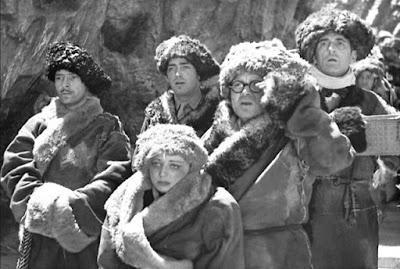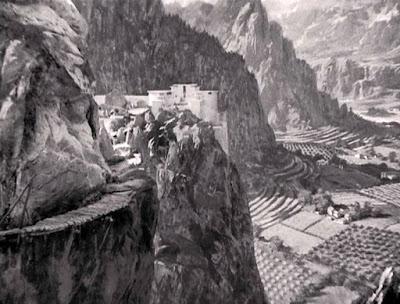
Frank Capra's wistful 1937 fantasy Lost Horizon begins dramatically with a chaotic mob scene at an airfield in war-torn Baskul, China, highlighted by a spectacular explosion and fire. In the midst of the fray, British diplomat Robert Conway (Ronald Colman) is managing the evacuation of 90 Westerners from the melee. But time is running out; he and a disparate party of five barely escape on the last plane to take flight. Struggling to board and flee with Conway are his younger brother, George (John Howard), Lovett (Edward Everett Horton), a paleontologist, Barnard (Thomas Mitchell), a businessman, and Gloria (Isabel Jewell), a floozy. Unbeknownst to the passengers, their European pilot, a crony of Conway's, was forcibly removed from the cockpit just before take-off and replaced by an Asian flyer.

Left to right: Mitchell, Horton, Colman, Howard and Jewell
The aircraft's spacious cabin promises as comfortable a journey as possible for the frazzled travelers. Resembling the interior of a plush Pullman lounge car, it sports roomy riveted-leather club chairs, polished wood paneling, stylish glass ball lamps atop glossy side tables and outsized windows offering expansive views of the terrain they will cross. In this posh setting the passengers begin to unwind. Lovett, a fussy eccentric, trades gibes with his worldly opposite, Barnard, a shady American. Gloria, a heavily rouged blonde, is unwell and her cough suggests a bad case of TB. George Conway, an impetuous sort, exults in his brother's heroism at Baskul's airstrip and his impending appointment to Foreign Secretary when they return to England. Robert Conway is diffident in the face of his brother's enthusiasm and seems far more exhausted than excited. As the flight lumbers on, Conway has a drink or two and as he nears inebriation he laments that though 90 Westerners were saved in Baskul, thousands of natives were left behind to be slaughtered. He goes on to bemoan the state of the world, bitterly asserting, "Everybody wants something for nothing - if you can't get it with smooth talk, you send your army in."
Last flight out

Unexplored territory
After a while it becomes obvious that the plane is off-course, flying west rather than east to Shanghai. Worse still, the group discovers that their original pilot has disappeared, that his replacement is brandishing a gun and that their flight has been hijacked. Through high winds and a blinding storm the stolen plane climbs up, up, up, threading its way between towering mountain peaks. Finally, out of fuel, it crashes in a snowbank. The pilot is found dead and Conway and the rest find themselves stranded in icy "unexplored territory." As Conway formulates a survival plan, a party of rescuers suddenly appears out of the snow-bleached landscape. Led by an enigmatic figure named Chang (H.B. Warner), the five are guided on a harrowing trek through snow fields, along perilous mountain paths and across a rickety footbridge until they reach an overlook that surveys what looks like a dream world: a compound of grand white buildings perched on a cliff above a lush valley, the Valley of the Blue Moon, in a land called Shangri-La.

Reacting to a first glimpse of Shangri-La

Shangri-la: the lamasery and the Valley of the Blue Moon
~
For many, just hearing the syllables "Shangri-La" stirs the imagination with visions of an idyllic utopia or unspoiled Eden. The word first appeared in British writer James Hilton’s novel Lost Horizon in 1933, referring to a faraway valley hidden in the Himalayas where life is peaceful, harmonious and bountiful. Hilton's book was published in the midst of the Great Depression, just as Adolf Hitler came to power and began his drive to inflict a grandiose and barbaric conception of Germany's so-called Third Reich on all of Europe. Lost Horizon's tale of a remote Tibetan land dedicated to protecting human knowledge and understanding against a looming world-wide calamity struck a deep chord at an uncertain time and became an immediate bestseller. Thanks to the novel and Frank Capra's film adaptation, "Shangri-La" entered the lexicon as a synonym for paradise.
Capra's production of Lost Horizon was an epic undertaking for the director and an event much anticipated by the legion of movie-going fans of the popular book. By the time filming began, Capra was riding very high. In 1935 It Happened One Night (1934) brought him the first of his three Oscars and Mr. Deeds Goes to Town (1936) was about to bring his second. He was the king of the Columbia lot and, increasingly motivated by artistic aspirations, ready to tackle a big picture with big themes. Hilton's story provided the ideal material for such ambition. And it helped that both Capra and his close collaborator, screenwriter Robert Riskin who'd brought the novel to him, both identified strongly with the story's protagonist, Robert Conway, a gallant and world-weary British consul on assignment in modern-day China.

Ronald Colman as Robert Conway
Lost Horizon would be Columbia Pictures’ most expensive venture up to that time, with enormous sums spent on Stephen Goosson's elegant sets recreating Shangri-La's lamasery compound, the film's central setting, and extensive location shooting. Snowy scenes were film in the downtown Los Angeles Ice and Cold Storage Warehouse. There, machine-made snow blanketed Himalayan sets. While most most Shangri-La exteriors were shot on Columbia's Burbank Ranch, location work included filming in Tahquitz Canyon near Palm Springs, Lucerne Dry Lake near Victorville, and Sherwood Forest (now Westlake Village) north of L.A. Capra even leased a Douglas DC-2 from American Airlines for the role of the hijacked airliner. The sets of Shangri-La were widely acclaimed, particularly those for the plane crash and the lamasery, and Stephen Goosson would take home the Best Art Direction Oscar for his efforts.Frank Capra was interested only in Ronald Colman for the role of Robert Conway and was willing to wait the two years it took for Colman to become available. The handsome British actor with the "crushed velvet" voice was a great star of Hollywood's classical era who projected a soulful gravitas that perfectly suited the disillusioned Conway character. Capra made sure Colman was supported by several first-rate featured players, most notably Mitchell, Horton and Warner.
~

The lamasery
Robert Conway, his brother, Lovett, Barnard and Gloria are taken to Shangri-La's lamasery, a breathtaking Tibetan moderne compound where they hope to rest and recuperate before beginning their sojourn back to civilization. Through Conway's ongoing dialog with Chang, the history and philosophy of Shangri-La emerge. Chang describe's a credo of moderation in all things, including virtue, and a core tenet of kindness and courtesy to others, always. Chang explains that there is no crime in the land and no monetary system. There is gold ore in the mountains, he tells Conway, and this gold is, from time to time, exchanged with the outside world for what is needed in Shangri-La. Since the Valley of the Blue Moon is fertile and the country produces its own food and most other goods, the gold is primarily traded for cultural materials and artifacts: mankind's important books, music and objects of art that are housed with care in the lamasery. Chang tells Conway of Shangri-La's origins in the 18th century when a Belgian priest, Father Perrault, came to the valley, the sole survivor of a religious expedition. Perrault stayed on to found a collective society, establishing its principles and way of life. Conway is fascinated and he finds that he feels contentment in Shangri-La, its tranquility gives him a sense of well-being and he realizes that this is a place where he might like to stay.Conway is later told that his plane was intentionally diverted because he was on board. Shangri-La's ancient High Lama (Sam Jaffe) has hopes Conway will some day take his place as the spiritual leader of the land. The other passengers acclimate to their surroundings at different rates and in different ways. It is the refusal of Conway's younger brother, George, to adapt at all that feeds a growing tension between them and leads to a moment of truth for Conway. In the end, he must choose between embracing this new-found world and his place in it or accepting his brother's rejection of it and leaving with him. Loyalty to his brother wins out and the two men, along with a woman George has become smitten with, attempt the treacherous journey back to civilization.

In the high mountains
Only Conway survives the expedition and it leaves him with a mysterious gap in his memory. Shipboard and on his way back to England, he suddenly recalls Shangri-La, that spiritual oasis in a world mired in an "orgy of greed and brutality." With memory restored, Robert Conway bolts from the modern world. By boat, by plane, by train, boat, but mostly by his wits and on foot he searches for the high mountain pass that will take him back to the paradise he found and lost.
Back in London Lord Gainsford, the foreign office man who tried to pursue Conway after he fled their homeward-bound ship, recounts the Conway saga over drinks with colleagues at his club. Asked whether he believes Conway's story, he considers and replies, "Yes, I believe it because I want to believe it," and raises his glass with, "I give you a toast. Here's my hope that Robert Conway will find his Shangri-La. Here's my hope that we all find our Shangri-La."

Frank Capra's Lost Horizon was nominated for seven Academy Awards including Best Picture; it won two, for art direction and film editing. The book made the reputation of James Hilton and he went on to have a successful career as both novelist and screenwriter. It took five years for Capra's adaptation to recoup its production costs but it became, and remains, one of the most beloved films in his canon. Though aspects of the story of Lost Horizon may seem dated today, Conway's spiritual yearnings and the ideal represented by Shangri-La hold an appeal that transcends changing times. ~
In 2005, the PBS series In Search of Myths & Heroes featured an episode on "The Search for Shangri-La." Shangri-La, it claimed, was James Hilton's fictionalization of the legendary Tibetan paradise of Shambala. The ancient myth of the lost sacred valley, it said, may actually have originated in India, and the story of Shambala first became known to Westerners when Europeans visited the Mughal Empire in the 16th century. According to the series, the legend tells of a land hidden deep in the Himalayas where an isolated society lives in accord with Buddhist teachings. The kingdom's mission is to preserve the wisdom of humanity, waiting for the day the world is ready to live in peace. The Dalai Lama has said that he believes Shambala exists purely as a spiritual realm and observes that “Tibetans say that the need to find paradise elsewhere is what keeps us from having it.”
~
This is my contribution to the Classic Movie Blog Association's fall blogathon, Planes, Trains, and Automobiles, click here for a complete listing of participants and links to their blogs.


